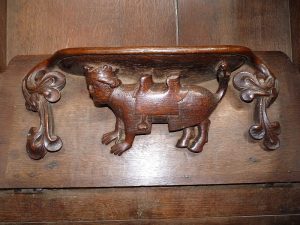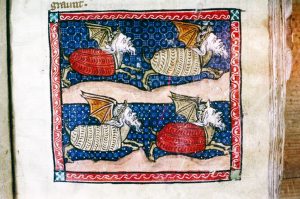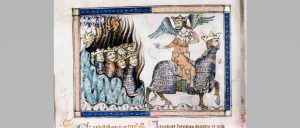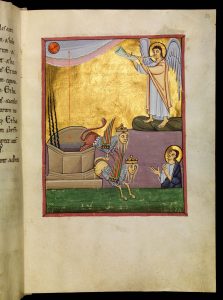I am Laura Jones, and I joined the project as a University of Exeter undergraduate Archaeology and History student in the summer of 2020. I am grateful to all the team for taking me on board and bringing me into the world of all things horse-related. Being a former secondary teacher, an intern at the University’s Digital Humanities Lab and a volunteer within the archaeology collections at the Royal Albert Memorial Museum in Exeter, I hope to bring my experience of material culture and public engagement to the project. Working alongside Rob Webley, I am focusing on the material culture package of the project that includes the Portable Antiquities Scheme’s (PAS) data to bring more understanding to our knowledge of medieval horse equipment – see Rob’s previous PAS post here. Whilst interpreting the PAS data, we have also been on a hunt for medieval horse iconography from across the UK/Europe to enhance our understanding of medieval horse equipment and how the medieval warhorse was perceived and represented.

Figure 1- Exeter Cathedral misericord of a locust like figure- ‘courtesy of the Dean & Chapter of Exeter Cathedral’ 2020.
Strikingly apparent is how the warhorse was an iconic figure within the medieval world and its imagination; most interestingly- and quite apt at the time writing, amidst the 2020 Covid pandemic – is how horses were depicted within medieval apocalyptic manuscripts. Brought to our attention by the Principal Investigator of the project Professor Oliver Creighton, is the representation on Misericord no. 41 (c.1240-70) at Exeter Cathedral (see Figure 1) of a locust-like figure – one of the Bible’s ‘locusts’ from the Book of Revelations (9:3). These locusts ‘“were like unto horses prepared for battle [with] breastplates of iron [and] their sound of their wings was as the sound of chariots [of] horses rushing to battle”’ (KJV, Rev. 9: 7-9). The locust figure is equipped with protective mail barding and a saddle with a high pommel and cantle – designed for keeping the rider on their horse. Does the representation of horse equipment in apocalyptic iconography, despite perhaps being as far removed from reality, give us some insight into medieval horse equipment? How did artists grapple with their depiction of ‘breastplates of iron’ in the phase prior to horse armour usage in the late 12th century in comparison to before plate armour was consistently used in the 14th century?

Figure 2: Selden Supra Part 2 Folio 69r, sourced from: Medieval and Renaissance Manuscript Illumination (from 35mm), Bodleian Libraries, University of Oxford.
Folio 94 – from Beatus of Liébana’s Las Huelgas Apocalypse (1220), now held in The Morgan Library and Museum, New York (MS M.429, f.94), depicts the riders wearing mail but not the locusts. On first inspection, one could assume the locusts could be wearing armour; the white highlights on the horses in the breast and hind regions create a shine to the locusts: something that is usually seen with armour. However, when compared to other depictions, it is clear the highlight accentuates the musculature qualities and powerful strength of those areas that drive the warhorse. The saddles once again hold their riders in with a high pommel and cantle. Using iconography, despite its artistic nature, therefore allows us to assess trends in horse equipment, how it was used and in combination with the archaeological data and to apply chronological information to it.

Figure 3: Canonici Apocalypse, Folio 10v, sourced from: Medieval and Renaissance Manuscript Illumination (from 35mm), Bodleian Libraries, University of Oxford.
Mail barding worn by horses was very common by the 13th century. Similar to the misericord at Exeter Cathedral are the examples of locusts wearing mail barding (see Figure 2) in the Selden Supra, circa 1315-1325 (MS. Selden Supra 38, Part. 2, f.69r). Another good example is seen in Figure 3 from the Canonici Apocalypse, 1320-1330 (MS. Canon. Bibl. Lat. 62, f.10v). This shows a range of horse equipment. The familiar trend of the saddle that holds its rider in (high pommel and cantle), a girth to keep the saddle in place and horseshoes which aid durability of the hoof are clearly illustrated, linking the locust to the figure of the warhorse. This folio clearly depicts the importance of horse equipment being suitable for battle. What is interesting is that it is rare to find mail barding depicted earlier than the 13th century. However, Rob Webley came across Folio 23 (Figure 4) from the Bamberger Apokalypse of c.1020 (Bamberg, Staatsbibliothek, Inventar-Nr. Bibl. 140, f. 23r.) which is one of the earliest examples of mail barding depicted in medieval iconography that we have personally found so far on a horse or horse-like figure.

Figure 4: Bamberger Apokalypse, Folio 23r, sourced from: Staatsbibliothek Bamberg, Msc.Bibl.140. Photo: Gerald Raab. Made available through CC-BY-SA 4.0.
These examples are relevant to our discussions of not only how the medieval warhorse and its equipment were perceived but also how and why they could have been used. Applying due source criticism, we can match up iconographical depictions with material culture, understand typologies within the equipment and try to establish chronological frameworks for our understanding of the medieval warhorse. As our iconographical horse hunt continues alongside our work on material culture for the project, it will be interesting to see what other depictions/material comes to light and what we can learn from them.